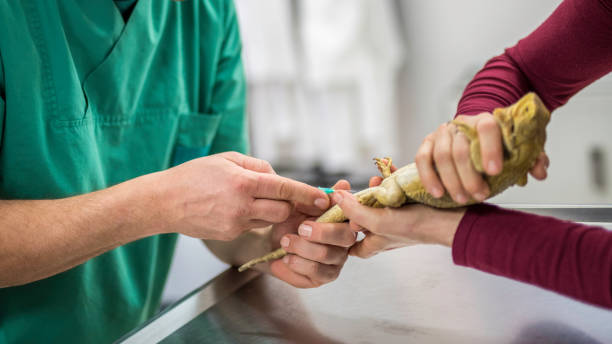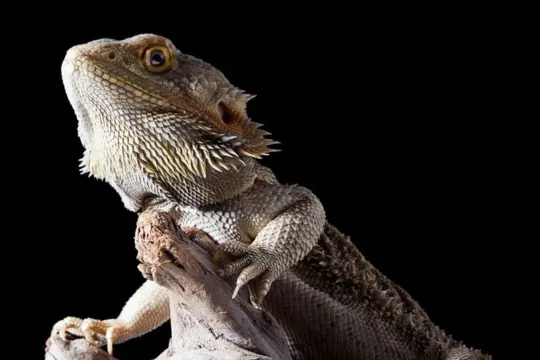Usually, when a bearded dragon turns white but doesn’t shed, it may be an indication that the environment is causing stress. Another possibility is that your bearded dragon is sick, infected with parasites, or experiencing organ failure. Vitamin deficiencies can also cause color changes in bearded dragons.
Possible Causes of White Coloration in Bearded Dragons

Bearded dragons are fascinating creatures that boast a wide array of colors and patterns. However, sometimes they can exhibit strange color changes, such as turning white but not shedding. Here are some possible causes.
Normal Color Changes During Shedding Process
When bearded dragons shed their skin, they often experience color changes as well. This is due to the outer layer of skin being shed, revealing the new layer underneath which may have a different color or shade. The new skin may appear paler or even white until it has fully matured.
Stress-Induced Color Changes
A stressed bearded dragon may exhibit strange color changes, including turning white. Stressors can include improper lighting or temperature in their enclosure, lack of hiding spots or proper substrate, excessive handling or noise, bullying from other pets in the household, and other environmental factors that cause anxiety for your pet.
Fungal or Bacterial Infections
If you see your bearded dragon turning white and there is no shedding going on at the moment it could also indicate an underlying fungal or bacterial infection on the skin which can cause discoloration and change in texture.
In this case, finding a veterinarian with experience treating reptiles should be your next step to ensure proper diagnosis and treatment.
Vitamin Deficiencies
Inadequate nutrition can lead to a host of problems for your beloved beardie. A vitamin deficiency, particularly calcium deficiency commonly causes these kinds of issues with pigmentation changes and abnormal shedding cycles among other symptoms like lethargy loss of appetite, etc.
Make sure to provide healthy greens like kale spinach collard greens etc along with insects like crickets roaches super worms hornworms etc and calcium dusting on their food to avoid such deficiencies.
It is important to note that any sudden color changes in your bearded dragon could be an indication of an underlying health issue.
As responsible pet owners or caretakers, it is our responsibility to monitor the well-being of our pets and seek veterinary help when necessary.
Diagnosis and Treatment Options

When it comes to bearded dragons, it’s always best to seek the advice of a veterinarian who specializes in reptiles. They have the knowledge and expertise necessary to diagnose any health issues that may be affecting your pet.
In order to determine the cause of your bearded dragon’s white coloration, a vet will typically perform an examination. During this exam, they’ll likely check for any signs of infection or other health issues that could be causing the problem.
They may also take a sample of your pet’s skin or blood for testing in order to rule out any underlying health problems.
Treatment options for fungal or bacterial infections
If your bearded dragon is diagnosed with a fungal or bacterial infection, there are several treatment options available. These may include medication such as antibiotics or antifungals that can be administered orally, topically, or through injections.
In addition to medication, it’s important to keep the enclosure clean and sterile in order to prevent reinfection. This means cleaning all surfaces regularly and providing fresh bedding materials on a regular basis.
Adjusting temperature and humidity levels
If your bearded dragon is not shedding properly due to environmental factors such as temperature or humidity levels being too low, adjusting these conditions can help promote proper shedding.
The ideal temperature range for bearded dragons is between 75-85°F (24-29°C) during the day and 65-75°F (18-24°C) at night. Humidity levels should also stay between 30-40%.
Providing additional sources of heat such as heating lamps or under-tank heaters can help regulate temperatures within this range.
In addition, providing adequate hydration by offering fresh water daily and misting their enclosure regularly can also help promote healthy shedding.
Conclusion
Summary of key points discussed throughout the article
Throughout this article, we have explored the various reasons why your bearded dragon may be turning white but not shedding. We have discussed the importance of proper shedding for a healthy bearded dragon and identified factors that can affect shedding, such as diet, hydration, and temperature.
We also looked at possible causes for white coloration in bearded dragons, including stress-induced color changes, fungal or bacterial infections, and vitamin deficiencies.
Importance of monitoring your pet’s health and seeking professional help when necessary
As a responsible pet owner, it is important to monitor your pet’s health to ensure they are thriving in their environment. Any changes in behavior or appearance should be noted and addressed promptly to avoid any potential health issues.
Seeking professional help from a veterinarian who specializes in reptiles is crucial if you suspect your bearded dragon is experiencing health problems.
Final thoughts on the importance of proper care for your beloved pet bearded dragon
Owning a bearded dragon can bring great joy and companionship into your life. However, it also comes with a great responsibility to provide proper care for these unique creatures.
By providing adequate nutrition, maintaining appropriate temperature and humidity levels in their habitat, offering regular opportunities for exercise and interaction with their owners, and monitoring their overall health status, you can ensure that your beloved pet will lead a healthy, happy, and long life by your side.
